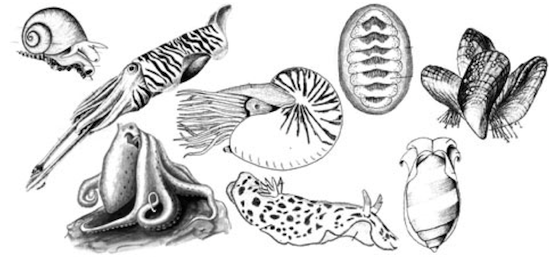
Mullusca Notes

The molluscs compose the large phylum of invertebrate animals known as the Mollusca. Around 85,000 extant species of molluscs are recognized. Molluscs are the largest marine phylum, comprising about 23% of all the named marine organisms. Numerous molluscs also live in freshwater and terrestrial habitats. They are highly diverse, not just in size and in anatomical structure, but also in behaviour and habitat. Cephalopod molluscs, such as squid, cuttlefish and octopus, are among the most neurologically advanced of all invertebrates—and either the giant squid or the colossal squid is the largest known invertebrate species. The gastropods (snails and slugs) account for 80% of the total.
Molluscs have more varied forms than any other animal phylum. They include the gastropods such as snails and slugs, bivalves such as the clams, cephalopods such as squids, cuttlefish, and octopuses, and other lesser-known but similarly distinctive subgroups. The majority of species still live in the oceans, from the seashores to the abyssal zone, but some form a significant part of the freshwater fauna and the terrestrial ecosystems. Molluscs are extremely diverse in tropical and temperate regions, but can be found at all latitudes.
The three most universal features defining modern molluscs are a mantle with a significant cavity used for breathing and excretion, the presence of a radula, and the structure of the nervous system. The ancestral mollusc is thought to have had a single, "limpet-like" shell on top, which was made of proteins and chitin reinforced with calcium carbonate, secreted by a mantle covering the whole upper surface. The underside of the animal consisted of a single muscular "foot". The "generalized" mollusc's feeding system consisted of a rasping "tongue", the radula, and a complex digestive system in which exuded mucus and microscopic, muscle-powered "hairs" called cilia played various important roles. Most molluscs have eyes, and all have sensors to detect chemicals, vibrations, and touch. The simplest type of molluscan reproductive system relies on external fertilization, but more complex variations occur. All produce eggs, from which may emerge larvae, more complex veliger larvae, or miniature adults.
Evidence exists for the appearance of gastropods, cephalopods and bivalves in the Cambrian Period some 541 to 485 million years ago. The Early Cambrian fossils Fordilla and Pojetaia are regarded as bivalves. Modern-looking bivalves appeared in the Ordovician Period, some 488 to 443 million years ago. One bivalve group, the rudists, became major reef-builders during the Cretaceous, but became extinct after the end-Cretaceous extinction event. Even so, bivalves still remain abundant and diverse.